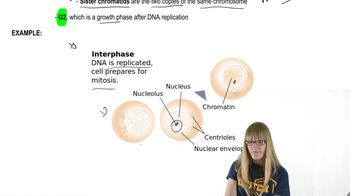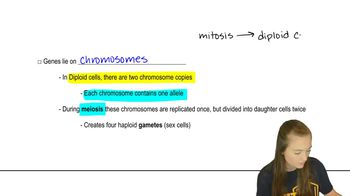The nuclear DNA content of a single sperm cell in Drosophila melanogaster is approximately 0.18 picogram. What would be the expected nuclear DNA content of a primary spermatocyte in Drosophila? What would be the expected nuclear DNA content of a somatic cell (non-sex cell) in the G1 phase? What would be the expected nuclear DNA content of a somatic cell at metaphase?
Table of contents
- 1. Introduction to Genetics51m
- 2. Mendel's Laws of Inheritance3h 37m
- 3. Extensions to Mendelian Inheritance2h 41m
- 4. Genetic Mapping and Linkage2h 28m
- 5. Genetics of Bacteria and Viruses1h 21m
- 6. Chromosomal Variation1h 48m
- 7. DNA and Chromosome Structure56m
- 8. DNA Replication1h 10m
- 9. Mitosis and Meiosis1h 34m
- 10. Transcription1h 0m
- 11. Translation58m
- 12. Gene Regulation in Prokaryotes1h 19m
- 13. Gene Regulation in Eukaryotes44m
- 14. Genetic Control of Development44m
- 15. Genomes and Genomics1h 50m
- 16. Transposable Elements47m
- 17. Mutation, Repair, and Recombination1h 6m
- 18. Molecular Genetic Tools19m
- 19. Cancer Genetics29m
- 20. Quantitative Genetics1h 26m
- 21. Population Genetics50m
- 22. Evolutionary Genetics29m
9. Mitosis and Meiosis
Mitosis
Problem 25
Textbook Question
Consider a diploid cell that contains three pairs of chromosomes designated AA, BB, and CC. Each pair contains a maternal and a paternal member (e.g., Am and Ap). Using these designations, demonstrate your understanding of mitosis and meiosis by drawing chromatid combinations as requested. Be sure to indicate when chromatids are paired as a result of replication and/or synapsis.
In mitosis, what chromatid combination(s) will be present during metaphase? What combination(s) will be present at each pole at the completion of anaphase?
 Verified step by step guidance
Verified step by step guidance1
Step 1: Understand the chromosome composition before replication. The diploid cell has three pairs of chromosomes: AA, BB, and CC. Each pair consists of one maternal (e.g., A^{m}) and one paternal (e.g., A^{p}) chromosome, so initially, there are 6 individual chromosomes (A^{m}, A^{p}, B^{m}, B^{p}, C^{m}, C^{p}).
Step 2: During the S phase before mitosis, each chromosome replicates to form two sister chromatids. For example, A^{m} replicates to form two identical sister chromatids, which remain joined at the centromere. This applies to all chromosomes, so each pair now consists of four chromatids (two sister chromatids per chromosome).
Step 3: At metaphase of mitosis, chromosomes align at the metaphase plate as sister chromatid pairs. Each chromosome is composed of two sister chromatids joined at the centromere. Therefore, the chromatid combinations present are pairs of sister chromatids for each chromosome: (A^{m} chromatids), (A^{p} chromatids), (B^{m} chromatids), (B^{p} chromatids), (C^{m} chromatids), and (C^{p} chromatids). There is no synapsis between homologous chromosomes in mitosis.
Step 4: During anaphase of mitosis, the sister chromatids separate and move to opposite poles. Each chromatid is now considered an individual chromosome. At the completion of anaphase, each pole will have one copy of each chromosome (one chromatid from each original pair), so each pole contains one set of chromosomes: A^{m}, A^{p}, B^{m}, B^{p}, C^{m}, and C^{p}, but as single chromatids, not pairs.
Step 5: Summarize the chromatid combinations: at metaphase, chromosomes are paired as sister chromatids (replicated chromosomes), and at the end of anaphase, chromatids have separated so each pole has one complete set of unreplicated chromosomes. There is no synapsis (pairing of homologous chromosomes) in mitosis.
 Verified video answer for a similar problem:
Verified video answer for a similar problem:This video solution was recommended by our tutors as helpful for the problem above
Video duration:
1mPlay a video:
Was this helpful?
Key Concepts
Here are the essential concepts you must grasp in order to answer the question correctly.
Chromosome Structure and Replication
Chromosomes consist of two sister chromatids joined at a centromere after DNA replication. Each chromatid is an identical copy of the original DNA molecule. Understanding when chromatids are replicated (S phase) and how they remain paired until separation is essential for analyzing chromatid combinations during cell division.
Recommended video:
Guided course

Chromosome Structure
Mitosis Phases and Chromatid Behavior
Mitosis is a process of nuclear division resulting in two identical daughter cells. During metaphase, replicated chromosomes align at the metaphase plate as paired sister chromatids. At anaphase, sister chromatids separate and move to opposite poles, ensuring each daughter cell receives one copy of each chromosome.
Recommended video:
Guided course

Mitosis Steps
Diploid Chromosome Pairing and Notation
Diploid cells have pairs of homologous chromosomes, one maternal (e.g., A^m) and one paternal (e.g., A^p). Recognizing these pairs and their chromatids helps track inheritance and chromatid combinations during mitosis. This notation clarifies which chromatids are identical sisters and which are homologs.
Recommended video:
Guided course

Diploid Genetics
Related Videos
Related Practice
Textbook Question
706
views


